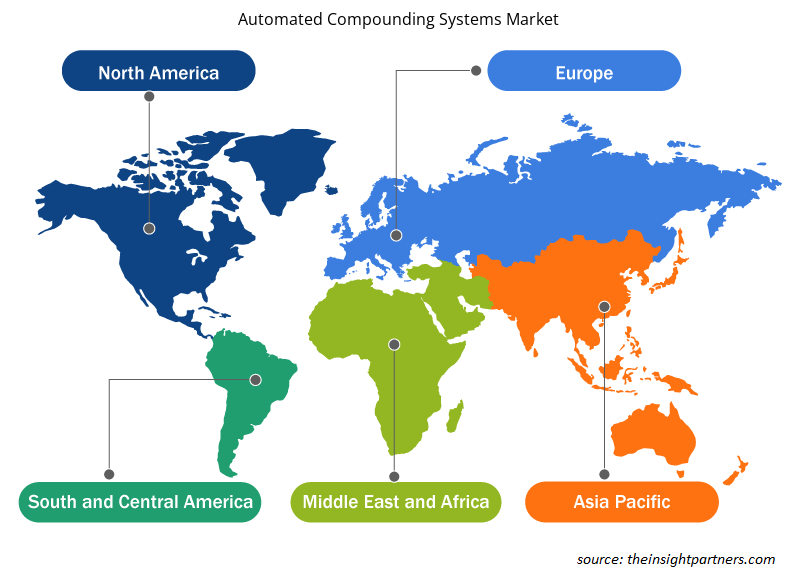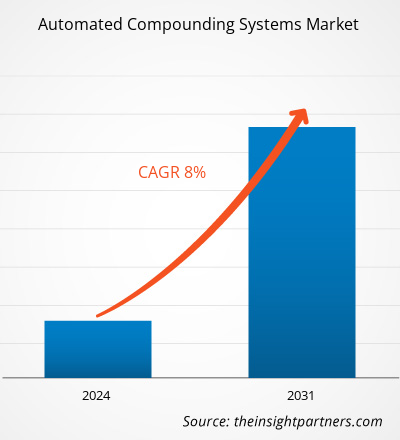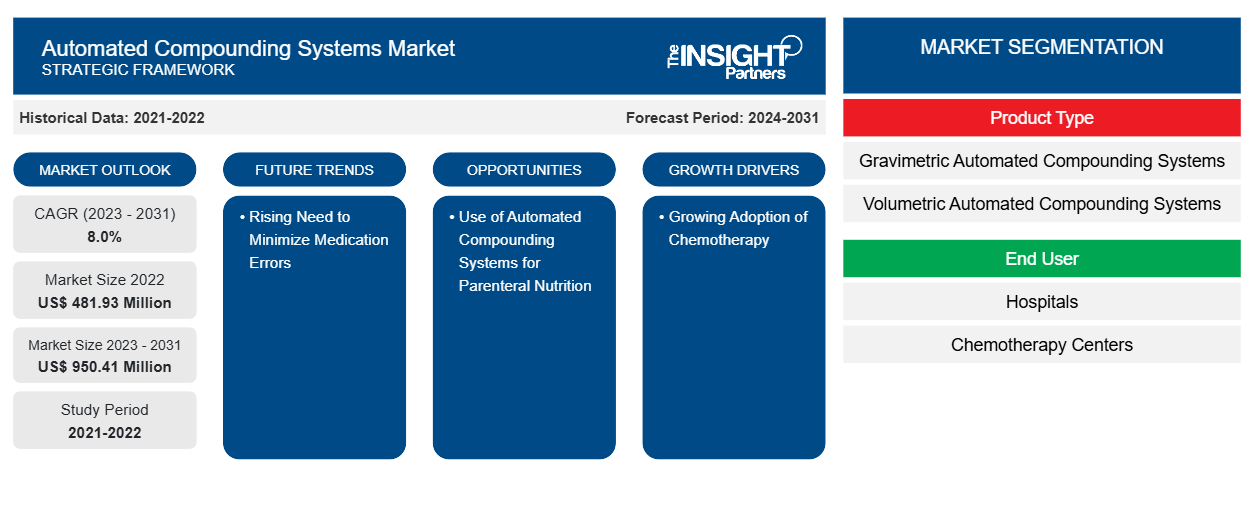自动配混系统市场规模预计在 2022 年为 4.8193 亿美元,2023 年为 XX 百万美元,预计到 2031 年将达到 9.5041 亿美元;预计到 2031 年的复合年增长率为 8.0%。战略发展和产品发布可能仍是自动配混系统市场的关键趋势。
自动配混系统市场分析
个性化药物需求的增加、患者安全性的提高、药物配制的严格规定、自动配药系统的效率和成本效益以及药剂师意识的提高,推动了自动配药系统市场的增长。此外,慢性病患病率的上升也刺激了对自动配药系统的需求。
自动配混系统市场概况
自动配药系统有助于避免因各种因素而发生的用药错误,例如医生和药剂师之间的管理沟通不畅、药房的储存规范不严格以及使用类似标签引起的混淆。此外,使用自动配药系统,配药产品的准确性和效率得到了提高,并进一步减少了医护人员接触有毒物质的机会。
定制此报告以满足您的需求
您可以免费定制任何报告,包括本报告的部分内容、国家级分析、Excel 数据包,以及为初创企业和大学提供优惠和折扣
-
获取此报告的关键市场趋势。这个免费样品将包括数据分析,从市场趋势到估计和预测。
自动配混系统市场驱动因素和机遇
减少用药错误的需求日益增加
用药和配药错误是世界各地医院再入院的主要问题。在患者护理的多个层面上,医务人员和医护人员都可能犯用药错误。用药错误可能由于多种因素而发生,例如医生和药剂师之间的沟通不畅、药店的危险储存做法以及由于使用相同标签而引起的误解。因此,必须进行多级监控。自动配药系统被认为是减少这些错误的最有效解决方案之一。各政府组织正在研究避免用药错误的措施,并开发克服这些错误的方法和系统,以便为患者提供适当的药物。因此,为了最大限度地减少用药和配药错误,一些国家的政府鼓励药房和医院使用自动配药和用药工具。这被认为是推动自动配药系统市场增长的主要因素。
自动配制系统在肠外营养中的应用——自动配制系统市场的机会
当患者因癌症和影响胃肠道的慢性疾病等疾病而无法满足营养需求时,需要进行肠外营养。这种营养是大多数严重短肠综合征 (SBS) 患者治疗的基石。每年每 100 万人中约有 3 人患有 SBS。根据 2020 年发表的题为“了解短肠综合征:现状和未来前景”的文章,SBS 的患病率在过去 40 年中增加了两倍多。在美国,患病率为每百万人约 30 例,在欧洲,患病率为每百万人约 1.4 例。自动配制系统可用于制造肠外营养产品。自动配制系统通常与专用软件相连,该软件以电子方式传输有关 PN 配方的信息。许多研究人员正在比较自动配制系统和手动方法制备的 PN 配方。正在进行的关于使用自动配制系统配制 PN 的研究预计将为自动配制系统市场的增长创造机会。
自动配混系统市场报告细分分析
有助于自动配制系统市场分析的关键部分是给药途径、应用和最终用户。
- 根据产品类型,自动配混系统市场分为重量法自动配混系统和体积法自动配混系统。重量法自动配混系统部分在 2023 年占据了最大的市场份额。
- 根据最终用户,自动配药系统市场分为医院、化疗中心和其他。医院部门在 2023 年占据了最大的市场份额。
自动配混系统市场份额分析(按地区)
自动配混系统市场报告的地理范围主要分为五个地区:北美、亚太、欧洲、中东和非洲、南美和中美。
北美主导着自动配药系统市场。北美市场的增长特点是慢性病药物需求增加、主要市场参与者的存在、产品推出的增加、美国自动配药系统的采用率不断提高、药品产量不断增加,这导致对药品自动灌装和包装的需求不断增加,以及学术和研究机构以及制药公司进行的广泛研发。此外,预计亚太地区将在未来几年录得最高的复合年增长率。
自动配混系统市场区域洞察
Insight Partners 的分析师已详细解释了预测期内影响自动配制系统市场的区域趋势和因素。本节还讨论了北美、欧洲、亚太地区、中东和非洲以及南美和中美洲的自动配制系统市场细分和地理位置。

- 获取自动配混系统市场的区域特定数据
自动配混系统市场报告范围
| 报告属性 | 细节 |
|---|---|
| 2022 年市场规模 | 4.8193亿美元 |
| 2031 年市场规模 | 9.5041亿美元 |
| 全球复合年增长率(2023 - 2031) | 8.0% |
| 史料 | 2021-2022 |
| 预测期 | 2024-2031 |
| 涵盖的领域 |
按产品类型
|
| 覆盖地区和国家 |
北美
|
| 市场领导者和主要公司简介 |
|
自动配混系统市场参与者密度:了解其对业务动态的影响
自动配料系统市场正在快速增长,这得益于终端用户需求的不断增长,而这些需求又源于消费者偏好的不断变化、技术进步以及对产品优势的认识不断提高等因素。随着需求的增加,企业正在扩大其产品范围,进行创新以满足消费者的需求,并利用新兴趋势,从而进一步推动市场增长。
市场参与者密度是指在特定市场或行业内运营的企业或公司的分布情况。它表明在给定市场空间中,相对于其规模或总市场价值,有多少竞争对手(市场参与者)存在。
在自动配混系统市场运营的主要公司有:
- 辛普维亚
- 百特国际公司
- 布劳恩梅尔松根股份公司
- 科梅瑟
- ICU 医疗公司
- 格里福斯公司
免责声明:上面列出的公司没有按照任何特定顺序排列。

- 获取自动复合系统市场顶级关键参与者概述
自动配混系统市场新闻和最新发展
自动配药系统市场通过收集一级和二级研究后的定性和定量数据进行评估,其中包括重要的公司出版物、协会数据和数据库。以下是自动配药系统和策略市场发展的列表:
- Simplivia 推出了创新的 SmartCompounders 化学自动化解决方案,该解决方案由领先的 Chemfort 封闭系统药物转移设备 (CSTD) 提供支持。它为药剂师和技术人员提供了工具,使配药过程更短、更可靠,并消除了药物识别和剂量数量的错误。(来源:Simplivia,公司网站,2024 年)
- 百特国际公司 (Baxter International Inc) 推出了 ExactaMix Pro 自动混料机。与 ExactaMix 相比,ExactaMix Pro 结合了增强的安全性、更直观、更高效的功能和更强大的处理能力。(来源:百特,公司网站,2022 年)
自动配混系统市场报告覆盖范围和交付成果
“自动配混系统市场规模和预测(2021-2031)”报告对市场进行了详细分析,涵盖以下领域:
- 范围内涵盖的所有主要细分市场的全球、区域和国家层面的市场规模和预测
- 市场动态,如驱动因素、限制因素和关键机遇
- 未来主要趋势
- 详细的 PEST/波特五力分析和 SWOT 分析
- 全球和区域市场分析涵盖关键市场趋势、主要参与者、法规和最新市场发展
- 行业格局和竞争分析,涵盖市场集中度、热点图分析、知名参与者和最新发展
- 详细的公司简介
- 历史分析(2 年)、基准年、预测(7 年)及复合年增长率
- PEST和SWOT分析
- 市场规模、价值/数量 - 全球、区域、国家
- 行业和竞争格局
- Excel 数据集
近期报告
客户评价
购买理由
- 明智的决策
- 了解市场动态
- 竞争分析
- 客户洞察
- 市场预测
- 风险规避
- 战略规划
- 投资论证
- 识别新兴市场
- 优化营销策略
- 提升运营效率
- 顺应监管趋势























 获取免费样品 - 自动配混系统市场
获取免费样品 - 自动配混系统市场